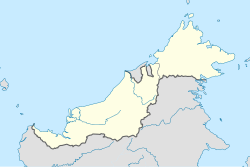
Bidayuh is the collective name for several indigenous groups found in southern Sarawak, Malaysia and northern West Kalimantan, Indonesia, on the island of Borneo, which are broadly similar in language and culture. The name Bidayuh means 'inhabitants of land'. Originally from the western part of Borneo, the collective name Land Dayak was first used during the period of Rajah James Brooke, the White Rajah of Sarawak. At times, they were also lesser referred to as Klemantan people. They constitute one of the main indigenous groups in Sarawak and West Kalimantan and live in towns and villages around Kuching and Serian in the Malaysian state of Sarawak, while in the Indonesian province of West Kalimantan they are mainly concentrated in the northern Sanggau Regency. In Sarawak, most of Bidayuh population can be found within 40 km of the geographical area known as Greater Kuching, within the Kuching and Serian Division. They are the second-largest Dayak ethnic group in Sarawak after the Iban and one of the major Dayak tribes in West Kalimantan.

Kanowit is a town and the capital of Kanowit District, Sibu Division, Sarawak, Malaysia, comprising 2,253.5 square kilometres. As of 2010, Kanowit's population is 28,985. It is built on the mouth of Kanowit River at the bank of Rajang River, approximately 174 kilometers from the coast of South China Sea. It takes 45 minutes to reach the town by land transport and an hour by boat from Sibu. The main ethnic groups are Iban, Chinese, Malay, and Melanau.

Mukah Division is one of the twelve administrative divisions in Sarawak, Malaysia. It was established on 1 March 2002 and it has a total area of 6,997.61 square kilometres.

Dalat is the administrative town of the Dalat district in Mukah Division, Sarawak, Malaysia. It is situated by the Oya river.
Melanau or A-Likou is an ethnic group indigenous to Sarawak, Malaysia. They are among the earliest settlers of Sarawak. They speak in the Melanau language, which is a part of the North Bornean branch of Malayo-Polynesian languages.

Bintulu is a coastal town on the island of Borneo in the central region of Sarawak, Malaysia. Bintulu is located 610 kilometres northeast of Kuching, 216 kilometres northeast of Sibu, and 200 kilometres southwest of Miri. With a population of 114,058 as of 2010, Bintulu is the capital of the Bintulu District of the Bintulu Division of Sarawak, Malaysia.

Kampong Sungai Teraban is a village in Belait District, Brunei, near the district's principal town Kuala Belait. It has an area of 22 square kilometres (8.5 sq mi); the population was 1,082 in 2016. It is one of the administrative villages within Mukim Kuala Belait.

Mukim Labi is a mukim in the interior of Belait District, Brunei. It has an area of 361.8 square kilometres (139.7 sq mi); the population was 1,216 in 2016.
Melanau is an Austronesian language spoken in the coastal area of the Rajang delta on northwest Borneo, Sarawak, Malaysia and Brunei. There are several dialects—Mukah-Oya, Balingian, Bruit, Dalat, Lawas, Igan, Sarikei, Segahan, Prehan, Segalang, and Siteng.

Balingian also known as Kuala Balingian is a town in Sarawak, Malaysia. It lies approximately 286.1 kilometres (178 mi) east-north-east of the state capital Kuching.
Kaul is a Melanau annual "cleansing" when traditionally, uninvited spirits and other bad influences were escorted out of the village by a flotilla of boats, and ceremonial offerings of food, cigarettes and betel nut were set on the Seraheng at the river mouth.
Sarawak's population is very diverse, comprising many races and ethnic groups. Sarawak has more than 40 sub-ethnic groups, each with its own distinct language, culture and lifestyle. This makes Sarawak demography very distinct and unique compared to its Peninsular counterpart. However, it largely mirrors to other territories in Borneo - Sabah, Brunei and Kalimantan.

Oya River is a river in Sarawak, Malaysia. The river mouth is located in Kuala Oya, Oya in Mukah Division. The river flows approximately 31 km and has a basin area of 2143.92 km2.

The Dalat District is located in Mukah Division, Sarawak, Malaysia. It is situated by the Oya river. The district covers areas from Kg. Penat to Oya, and from Muara Sg. Kut to Ulu Baoh. The district has an area of 905.29 km2, while the Oya sub-district has an area of 147.47 km2.

Fatimah Abdullah née Ting Sai Ming is a Malaysian politician from the Parti Pesaka Bumiputera Bersatu (PBB), a component party of the ruling Gabungan Parti Sarawak (GPS) coalition. She has served as the State Minister of Women, Early Childhood and Community Wellbeing Development of Sarawak under Chief Ministers Abang Abdul Rahman Johari Abang Openg, Adenan Satem and Abdul Taib Mahmud since September 2011 as well as and Member of the Sarawak State Legislative Assembly (MLA) for Dalat since September 2001.

Mukah (muːkəh), historically known as Muka is a coastal town which serves as the capital and the administrative center of the Mukah Division since 1 March 2002.
Ratu Teluwaih Jinih is a local beauty pageant based in Mukah, Sarawak. Began in 2008, it is the centerpiece of the Mukah Kaul Festival, which usually lasts a week.

Tebedu District is a district in the state of Sarawak, Malaysia. It is a part of Serian Division that consists of Serian, Siburan, and Tebedu districts. Before this, Tebedu District was a sub-district under Serian District which was then fully upgraded to a district in its own right. The majority of the population of this district is from the Bidayuh ethnic group.
Igan is a village and a subdistrict in Matu District, Mukah Division, Sarawak, Malaysia. It is situated near the mouth of Igan River with the South China Sea. Igan is about 50 kilometres to the west of Mukah, the division's administrative town, where as the nearest town is Oya with a distance of about 23 kilometres. Igan is a type of fish that can only find around the village.















